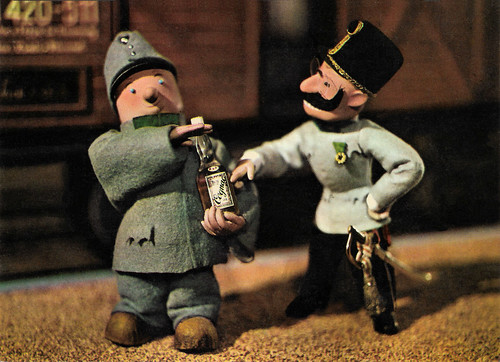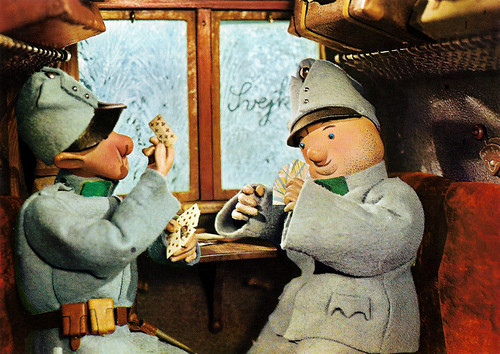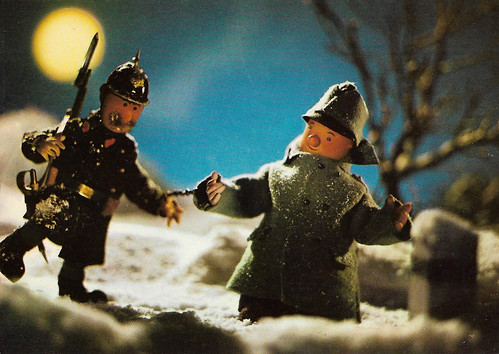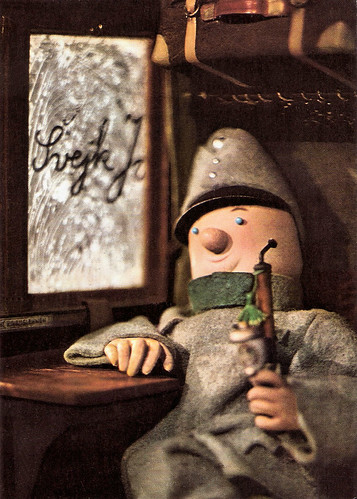
Czechoslovakian postcard by Tisk Severogravia Decin, no. 10-521-O-1. Photo: still from Dobry vojak Svejk/The Good Soldier Svejk (Jirî Trnka, 1955).

Czechoslovakian postcard by Tisk Severogravia Decin, no. 10-521-O-2. Photo: still from Dobry vojak Svejk/The Good Soldier Svejk (Jirî Trnka, 1955).

Czechoslovakian postcard by Tisk Severogravia Decin, no. 10-521-O-3. Photo: still from Dobry vojak Svejk/The Good Soldier Svejk (Jirî Trnka, 1955).

Czechoslovakian postcard by Tisk Severogravia Decin, no. 10-521-O-4. Photo: still from Dobry vojak Svejk/The Good Soldier Svejk (Jirî Trnka, 1955).

Czechoslovakian postcard by Tisk Severogravia Decin, no. 10-521-O-5. Photo: still from Dobry vojak Svejk/The Good Soldier Svejk (Jirî Trnka, 1955).
Brothers in tricks
Jiří Trnka was born in the city of Pilsen, in western Bohemia, Austria-Hungary (now Plzeň, Czech Republic) in 1912. Although his father was a plumber and his mother a dressmaker, both remained very close to their peasant origins. From the moment he could hold a pencil, Jiří drew pictures. Young Jiří also enjoyed sculpting puppets made of wood and put on small shows for friends. At secondary school, his drawing teacher was Josef Skupa, who eventually would become a leading public figure in the world of Czech puppeteers.
Skupa became his mentor, entrusted Trnka with certain responsibilities, and managed to convince his family, who were initially reluctant, to allow him to enroll at the prestigious School of Applied Arts in Prague, where he completed his apprenticeship between 1929 and 1935. Trnka soon began a successful career as an illustrator. He was hired by the Prague publishing house Melantrich, and his first illustrated work was 'Tygr pana Boška' (The Tiger of Mr. Bošek) by Vítězslav Šmejc, published in 1937.
Since then, Trnka illustrated numerous children's books. Throughout his life, he illustrated 130 works of literature, most of them for children. Especially famous are his illustrations for the tales of the Brothers Grimm, as well as collections of folktales from Czech authors such as Jiří Horák and Jan Páleníček. Also related to his native folklore are his illustrations for 'Bajaja' by Vladimír Holan, published in 1955, which would also be the starting point for his future in animation. In addition to the above, Trnka illustrated the tales of Hans Christian Andersen and Charles Perrault, the fables of Jean de La Fontaine, 'The Thousand and One Nights', several works of William Shakespeare, and Lewis Carroll's 'Alice in Wonderland'.
In 1936 Trnka also began a wooden puppet theatre on Prague’s Wenceslas Square, which was disbanded after the outbreak of World War II. During the war, he designed stage sets and illustrated Špalíček veršů a pohádek, a collection of Czech rhymes and fairy tales by František Hrubín.In the immediate wake of World War II, Trnka founded Bratři v triku (Brothers in tricks) with fellow animators Eduard Hofman and Jiří Brdečka. This studio, dedicated to the production of traditional, hand-drawn animation, lives on today.
Their first film was Zasadil dědek řepu/Grandpa Planted a Beet (1945). Then, Trnka had three hand-drawn shorts screened at the first Cannes Film Festival in 1946. While Dárek/The Gift was received as a truly radical work, it was Zvířátka a petrovští/The Animals and the Robbers (1946) which won Trnka the Grand Prix. Cerise Howard at Senses of Cinema: 'Despite the bouquets for Trnka’s cartoons, he was eager to move on to animating puppets. He was dissatisfied with the industrial nature of drawn animation, feeling that 'too many middle-men (artists, colour technicians) weakened the originality of the author’s drawings'. Furthermore, he was keen to create and shoot in three dimensions." He presented the ten-minute-long puppet film Christmassy Betlém/Bethlehem, which captures the atmosphere of a Czech folk Christmas and was a remarkably accomplished debut.
Trnka's first feature-length puppet film with the help of Břetislav Pojar, Špalíček/The Czech Year (Jiří Trnka, 1947), which told six separate folk tales of Czech life, based on a book illustrated by Mikoláš Aleš. It was a defining moment for Trnka as he won a Lion at the Venice Film Festival and several other international awards, three years running across Europe. Trnka’s growing prestige was something the Communist Party wanted a piece of upon their assumption of control of Czechoslovakia in early 1948. Henceforth, all of Trnka’s subsequent output was subsidised by the state, a situation which, just as for many compatriots in animation and in live-action, was liberating even as it was stifling.
The next film they produced was Cisaruv Slavik/The Emperor's Nightingale (1949), based on the 1843 fairy tale 'The Nightingale' by Hans Christian Andersen. Unlike the previous, it is a real feature film with one single storyline. Puppet animation is a traditional Czech art form, of which Trnka became the undisputed master. Most of his films were intended for adults and many were adaptations of literary works. These included feature-length covering working-class traditions and national heroes, such as Bajaja/Prince Bayaya (Jiří Trnka, 1950), and Staré povesti ceské/Old Czech Legends (Jiří Trnka, 1953). They made him an internationally recognised artist and the winner of film festival awards. He was a puppet-maker, a sculptor, and a set and stage designer. All of these talents were abundantly well utilised in his highly distinctive film work.

Czechoslovakian postcard by Tisk Severogravia Decin, no. 10-521-O-7. Photo: still from Dobry vojak Svejk/The Good Soldier Svejk (Jirî Trnka, 1955).

Czechoslovakian postcard by Tisk Severogravia Decin, no. 10-521-O-8. Photo: still from Dobry vojak Svejk/The Good Soldier Svejk (Jirî Trnka, 1955).

Czechoslovakian postcard by Tisk Severogravia Decin, no. 10-521-O-9. Photo: still from Dobry vojak Svejk/The Good Soldier Svejk (Jirî Trnka, 1955).

Czechoslovakian postcard by Tisk Severogravia Decin, no. 10-521-O-10. Photo: still from Dobry vojak Svejk/The Good Soldier Svejk (Jirî Trnka, 1955).
Anti-war satire
To explore the classics of Czech literature, Jiří Trnka decided in 1955 to adapt to the screen the immensely popular novel Osudy dobreho vojaka Svejka za svetove valky (The Good Soldier Švejk) written by Jaroslav Hašek. This anti-war satire is the most translated novel of Czech literature.
At the time, there already existed film adaptations with real actors, such as Dobrý voják Švejk/The Last Bohemian (Martin Frič, 1931), starring Saša Rašilov as Švejk. Trnka however was the first to make an animated film about the bumbling soldier who earnestly attempts to follow orders. For the construction of the puppets, Trnka was inspired by the illustrations for the original book made by Josef Lada, which in the popular imagination were closely associated with the characters of Hašek.
Dobry vojak Svejk/The Good Soldier Svejk (Jirî Trnka, 1955) is divided into three episodes, which tell the grotesque adventures of Švejk during World War I. The first episode takes place in a small station between Hatvan and Halič. The soldier Svejk is suspected by his superior of having drunk cognac which is strictly forbidden. He invents a story about sleeping on his feet to get out of the situation. In the second episode, Svejk accompanies an officer to the front. On the train, he accidentally triggers an emergency stop, which gets him into some trouble. And in the third episode, Svejk cannot find his battalion. A Russian spy interrogates him and a policeman has to escort him to the city. But this one being dead drunk, it is finally Svejk who brings him back to the police station.
The narrator of Dobry vojak Svejk/The Good Soldier Svejk was Jan Werich, who also co-wrote the script for the film with Trnka. Trnka himself felt that the final episode was the most artistically successful, but there's much to enjoy in all three, not least the way that the lackadaisical layabout Svejk's own self-serving anecdotes are realized through cut-out animation. The humorous film received awards at international festivals in Karlovy Vary, Locarno, and Montevideo.
Trnka's masterpiece was Sen noci svatojánské/A Midsummer Night’s Dream (Jirî Trnka, 1959), adapted from one of the most famous works of William Shakespeare. Trnka had previously illustrated this book so he knew it well. It was presented in Cannes in 1959 and was a resounding international success. Trnka was called the icon of ‘Eastern country’ animators. Cerise Howard at Senses of Cinema: “a stunningly beautiful, highly faithful adaptation of Shakespeare’s play. Several years in the making, the puppet animation is more liquid, more balletic than ever.”
Afterward, the filmmaker stopped making feature-length films. Over the next decade, the filmmaker made only a few short films, which were progressively in a pessimistic tone, such as Kybernetická babička/The Cybernetic Grandma (Jirî Trnka, 1962), a satire on the increasing importance of technology in everyday life. Archanděl Gabriel a paní Husa/The Archangel Gabriel and Ms. Goose (Jirî Trnka, 1964), set in medieval Venice, adapts one of the stories of the Decameron by Boccaccio. Trnka's last film, Ruka/The Hand (Jirî Trnka, 1965), was an unexpected and surprising break in his work thus far. In short, it is about a sculptor visited by a huge hand, which seeks the completion of a sculpture of itself. By rejecting the imposition, the artist is constantly pursued by the hand, ending with induced suicide and the hand officiating at his funeral. Ruka is considered a protest against the conditions imposed by the Czechoslovak communist state to artistic creation, and even some have seen in it an anticipation of the so-called Prague Spring.
In 1968, he received the international Hans Christian Andersen Medal for illustrators, recognising his career contribution to children's literature. Jiri Trnka died of complications from a heart condition in 1969 in Prague, only 57 years old. His funeral, held in Pilsen, was a large public event. Although The Hand initially had no problems with censorship, Trnka's film was banned four months after his death. All copies were confiscated by the secret police, put in a safe, and the film was forbidden for screening for the next twenty years.

Czechoslovakian postcard by Tisk Severogravia Decin, no. 10-521-O-11. Photo: still from Dobry vojak Svejk/The Good Soldier Svejk (Jirî Trnka, 1955).

Czechoslovakian postcard by Tisk Severogravia Decin, no. 10-521-O-12. Photo: still from Dobry vojak Svejk/The Good Soldier Svejk (Jirî Trnka, 1955).

Czechoslovakian postcard by Tisk Severogravia Decin, no. 10-521-O-13. Photo: still from Dobry vojak Svejk/The Good Soldier Svejk (Jirî Trnka, 1955).

Czechoslovakian postcard by Tisk Severogravia Decin, no. 10-521-O-14. Photo: still from Dobry vojak Svejk/The Good Soldier Svejk (Jirî Trnka, 1955).

Czechoslovakian postcard by Tisk Severogravia Decin, no. 10-521-O-15. Photo: still from Dobry vojak Svejk/The Good Soldier Svejk (Jirî Trnka, 1955).
Sources: Cerise Howard (Senses of Cinema), Edgar Datko (Animation World Magazine), Daniel Yates (IMDb), Thierry Méranger (Europe od Cultures), Dangerous Minds, Wikipedia (English and French), and IMDb.
2 comments:
Great post! I love the postcards and would love to see the film (with English subtitles...)
EYE is screening Jiri Trnka's The Good Soldier Svejk films on March 17th as part of the WW I program. For more details check http://www.eyefilm.nl/ji%C5%99%C3%AD-trnka%E2%80%99s-de-brave-soldaat-%C5%A1vejk-lezing-carlos-reijnen?show_id=1073028
Post a Comment